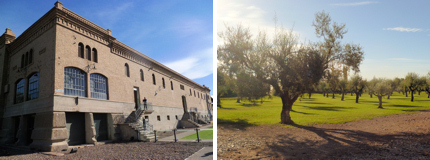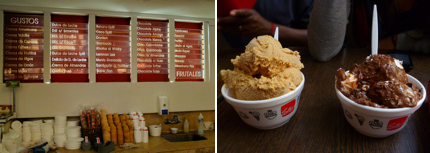A gourmet's guide to Argentina
Argentina is famous for its beef – arguably the best in the world – but that's not all it's good for. Jane Duru takes a culinary tour outside the capital of Buenos Aires to discover what foodie experiences lie beyond.
On Mendoza’s Uco Valley trail
Glug, glug, glug. The only sounds to be heard in the room are the appreciative murmurs of my group, as we sniff and taste our way through a selection of wines at Argentina’s biggest wine exporter, Trapiche. We’re in the Uco Valley, the newest wine-producing area within the northwestern Mendoza province. My culinary adventure is starting in this northern region of Argentina, where the dun-coloured desert scrublands meet the craggy white-tipped mountains of the Andes. A mere 90 minute flight from Buenos Aires, the wine region is one of the key stops on any culinary itinerary of the country.
Half an hour from Mendoza city, the impressive grounds of Trapiche are the first stop. Founded in 1883, the winery has been producing wines for over 100 years, now encompassing over 1,200 hectares (2,65 acres) of land. “Fifty years ago, the only question you asked was: ‘Do I want red or white?’ The answer was: ‘A lot!’” says Luciano, our prim-looking tour guide as we wander around the huge complex, starting at the on-site museum filled with old wooden presses and machinery before moving into the area where tanks holding fermenting wine sit and boot-clad workers go about their mysterious ways. The sweet, yeasty fumes are an assault on the nose.
 Trapiche's restored factory; olive trees in the grounds
Trapiche's restored factory; olive trees in the groundsIn the plush surroundings of the tasting room, a barn-like structure with soaring wooden beams, where glass panels in the wooden floor allow a glimpse into the barrel room beneath, we start our tasting with a 2012 Torrontés. The white wine is produced from the only native Argentine grape, usually in higher altitudes of the Cafayate and Salta.
Invited to smell and swirl the glass before drinking, I’m warned that this is known as ‘liar’s wine’. I soon see why; what smells like an aromatic sweet wine turns out to be much drier and acidic tasting, rather more like a sauvignon blanc. We move through other varieties, including a wine from the Iscay series created by winemaker Daniel Pi and an unblended Malbec from the 2009 Terroir series, which goes down well. As Luciano says in almost reverential tones: “Wine is something you have to take in its context – you can’t separate it.” In this setting, I can see exactly what he means.
Until the mid-20th century wine consumption for the average Argentine was a liver-bashing 90l per year, tailing off to under 30l by the 1970s as locals discovered a taste for beer and coke. However, despite declining domestic demand, the past 30 years have seen Argentina’s wine export industry take off, catalysed by the rest of the world discovering its most emblematic product: the Malbec grape. A purple grape originally grown in France, it was found to be particularly well-suited to the high altitude, sunny desert climate of Mendoza, producing a pungent, spicy red wine that eclipses most other varieties in popularity.
Viticulture was traditionally located in the Valley de Lujan de Cuyo, on the outskirts of the city, but as land became more expensive, and competition for water rights between the expanding city and the wine producers grew, producers were prompted to search for pastures new. They found the Uco Valley, a higher-altitude area, 80km (50 miles) southwest of Mendoza, in the foothills of the Andes. Always seen as having potential but lacking in the flood irrigation that would be appropriate for grape growing, the onset of drip-feed irrigation 20 years ago (a technique where the amount of water fed to the vine can be remotely controlled through a system of cables along the roots of the vines), has meant the area’s potential could be made reality and slowly, the wineries have moved in, leading the Uco Valley to be touted as Argentina’s version of Napa Valley.
 A bottle of Iscay series wine; Salentein's designer winery
A bottle of Iscay series wine; Salentein's designer wineryJane Duru
Further stops on the Uco Valley tour include the luxurious Andeluna winery, where I’m introduced to the Altitud Malbec 2011 and the Pasionale, a rare beast: a straight cabernet franc wine. The grape is usually only used in blends, but this has a sweet, earthy, peppery taste. Lastly, I visit Salentein, famous not only for its wine (they provided the wine for the Dutch royal wedding) but the attached gallery displaying the owner’s private art collection. Guided by the informative Luis around the shrivelled, spindly vines, it’s a relief to pass from the scorching sun outside, down into the dark cool enclaves of the winery. However, this is no merely functional storage space; it feels like a Masonic temple, with barrels arranged in circles around a central star motif set into the stone floor. After gargling my way through a Chardonnay, Merlot, Malbec and Numina (the house blend of five different grapes), I’m left with the sense that wine in Mendoza isn’t merely to be celebrated, but worshipped too.
Rolling through Rosario
Argentina has more to offer the gourmand than excellent wine, however. Next stop on the gourmet tour is Rosario, a city around 900km (560 miles) east of Mendoza, and a 30 minute flight from Buenos Aires. Located on the western bank of the Paraná river and founded in the 17th century, it’s often likened to Buenos Aires in miniature, its main claim to fame being that it’s the birthplace of Che Guevara and Lionel Messi. It may seem an unlikely gastronomic heartland but the legacy of Argentina’s European heritage, with Spanish and Italian immigrants having brought their cuisine means that perhaps it’s not just nationalistic hubris when the mayor declares: “Last century was for cinemas and music; this will be the century for taste.”
 Rosario is the unofficial ice cream capital of Argentina
Rosario is the unofficial ice cream capital of ArgentinaJane Duru
There are signs it’s rubbing off on the city, not least with its unofficial title as the ‘capital of ice cream’ – there are over 20 ice cream parlours within 20 blocks, and a National Ice Cream festival is held every October. Paying a visit to Heladerias Esther on Pelligrini Avenue has me vowing to ditch the Haagen Dazs; this is truely artisanal ice cream. I want to eat everything, from the ubiquitous dulce de leche (a sweet gooey caramel spread that Argentines eat with everything), to the creamily indulgent Sabayon (a port-flavoured concoction). All of the ice cream is produced on site, using original fruits and ingredients rather than powdered flavouring and the 40 year old family-run institution is one of the most popular spots in the city, selling over 2000l of ice cream on a hot summer’s day; I spy both young and old indulging in generous servings on my visit.
Pride in fresh local ingredients is clearly running high in this city as Argentines begin to rediscover their own culture and local dishes make a resurgence. Other notable regional specialities include salted medialuna (rather than the sweet form found everywhere else), and the ‘Carlito’ sandwich – a sort of toasted sandwich made of crustless thin bread and filled with tomato ketchup, ham and cheese. An award-winning urban garden initiative founded by unemployed local women on Rosario’s outskirts supplies markets in the city with fresh fruit and vegetables, whilst restaurants such as Sunderland and fine-dining spot Pobla del Mercat are eager to promote their use of local ingredients.
 River fish are a Rosarian speciality
River fish are a Rosarian specialityJane Duru
Proximity to the river means fish rather than beef, gets top billing on menus – this is one of the only places to find fish empanadas – and at the local fish shacks near the Rambla Catalunya beach area, hang the ugliest fish I’ve ever seen – catfish, dorada, surubi, boga. Just a few metres walk away at Escaurizo Parilla, a long-standing restaurant packed with locals, I find them cooked on the parilla (grill), and served up with chimichurri (a parsley, oregano, garlic and oil sauce), much the same way beef is served in the rest of the country, and almost as meaty – it's fish and chips, Argentine-style. While Buenos Aires may garner the lion's share of the attention, both Rosario and Menedoza prove that it pays to look beyond the capital.
-------------------------------------------------------------------------------------
NEED TO KNOW
Getting there: Air Europa flies from London to Buenos Aires (via Madrid) with return fares starting from £624 per person. This also includes a free return bus journey from Ezeiza airport to Rosario. Fares with Air Europa from London to Mendoza (via Buenos Aires) are from £758. All flights include taxes, complimentary food and drinks onboard and 23kg hold luggage. For internal flights Aerolineas Argentinas has a Visit Argentina pass for two return flights linking Buenos Aires to Mendoza and Rosario. Fares start from £450 plus tax.
Where to stay: In Mendoza city, Hotel Internacional (tel: +54 261 425 5600) is located moments from the central piazza and makes a good base for exploring the city. If you want to be located in the wine region, Entre Cielos in Lujan de Cuyo (tel: +54 261 498 3377) is a luxury boutique hotel where rooms are decorated with quirky individual touches and there is an excellent restaurant on site.
Getting around: Extensive touring around the Mendoza region will require road transport, but private guides are available to hire in Mendoza city and it's possible to do self-guided tours by bicycle. Many wineries run daily tours but this may vary depending on the time of year, and tours should be booked in advance where possible. In Rosario, car transport is the best way to get around, although many of the central areas are easily walkable.
More information: Find out more at Visit Argentina.
Do you have any Feedback about this page?
© 2025 Columbus Travel Media Ltd. All rights reserved. No part of this site may be reproduced without our written permission, click here for information on Columbus Content Solutions.









 You know where
You know where